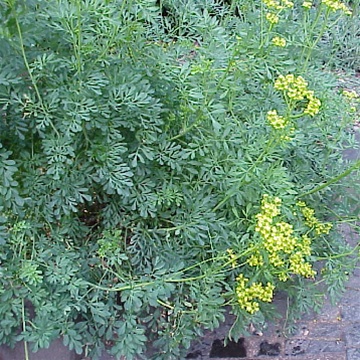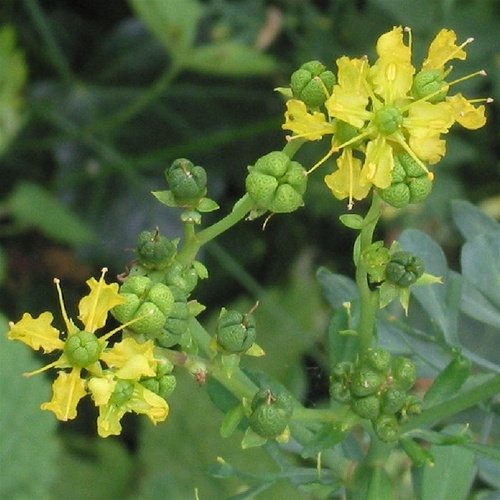Though Rue’s rich history is merely a memory to many these days, this hardy perennial herb still has a lot to offer. From the mystical to the mundane, Rue has been a popular herb throughout time with many modern applications that are often overlooked. A flavorful herb to season your favorite dish when used sparingly, an attractive organic insect and pest repellent, and a powerful natural antispasmodic, Rue is a terrific aromatic herb for any garden.
Also commonly known as ” the Herb of Grace” or the “herbe a’la belle fille” (the Herb of Fair Maidens) in France, Rue has long been a symbol of virtue and purity. As part of traditional Lithuanian wedding rites, the bride wears a crown of Rue which is burned during the ceremony to symbolize her transition from the whimsy and virtue of childhood to the responsibilities of motherhood and adulthood. A sprig of Rue is also presented to the marrying couple to lend clarity to their marriage. In many parts of the world, Rue was also used to repel witches and evil spirits because of its strong, pungent odor and effect on the body. Sprigs of Rue were ingested to guard against spells, and was considered a very reliable “anti magic” defense. This belief started with Ancient Greeks who, when dining in the company of strangers, ate Rue to calm their indigestion, which they attributed to their new guests using witchcraft to cast spells upon them. Ironically, Rue was also used in witchcraft to create and cast spells. Because of the herb’s astringent and abortive properties Rue was used to poison, blister, and in some cases, make the victim of the spell miscarry. Rue was also used to give a person “second sight” and was believed to help see into the future. This old-world reverence of Rue as a sacred herb and guard against evil also manifests itself in the Catholic Church, where it is dipped in Holy Water during High Mass and then sprinkled over parishioners to bless them.
Also heavily used in art and literature, Rue is closely related to regret or remorse and even the word “rue” in its literal sense means to repent or lament. Mentioned by Milton, Shakespeare and in the Bible, in the Book of Luke, Rue is used as a constant symbol of guilt, sorrow and anguish. It was common to eat Rue among Italian artists, including Michelangelo and da Vinci, to sharpen their creativity and eye sight during tedious periods of painting or sculpting. The strong, bitter taste of the Rue was thought to awaken the senses and encourage productivity. This thought that Rue could aid eyesight was also shared by expert marksmen who coated their gun flints and bullets with a mixture that included Rue to make their aim more true.
Rue has lost its popularity as a modern medicinal herb because of its bitter taste, its ability to nauseate and poison if taken in too large a dose, and the difficulty to harvest it due to allergic reactions with the plant’s oil when combined with UV light. This phenomenon is called Phytophotodermatitis and can be contracted when your skin comes into contact with the Rue plant in direct light. The plant’s oils are activated by the light and can cause very painful blistering, rashes and skin irritation, similar to poison ivy. Characteristic of all members of the Citrus family, Rue shares this quality with Lemons, Oranges and Limes. The best way to avoid this painful reaction is to wear long sleeves and gloves when tending Rue and to harvest it early or late in the day when the sun’s rays are weaker. Washing affected areas quickly can help alleviate the reaction, as well as applying Aloe, Calendula or over the counter antihistamines directly to the points of contact. Rue was traditionally used for its powerful emmenagogic properties (an agent that encourages menstrual flow), by women suffering from various menstrual problems, but is no longer deemed a safe alternative to other herbal antispasmodics because of the high chance of miscarriage. This being said, Rue should never be handled or ingested by pregnant women.
Rue’s most present-day use is in the kitchen as a culinary herb, and it is the staple of many cultural foods throughout the Mediterranean, Greece, Italy and Ethiopia. Used in small quantities, as it packs a potent punch and tends to overwhelm a dish easily, Rue is a strong, savory herb. When dried, the herb takes on a more bitter taste which comes from the presence of Rutin, a chemical also found in Watercress, Capers and Orange Peel. In Ethiopia, the leaves and berries of the Rue plant are used to create a traditional spice mix called Berbere and it is used in many Mediterranean recipes to lend a strong flavor to fish, cheese and meats. Because its taste is complimented by other savory herbs, Rue is a great addition to Italian recipes like tomato sauces that require Capers, Marjoram, Basil and Lovage. To lessen the bitterness of this multipurpose herb, extract just the oil from the Rue leaves by adding it in for a few minutes at the end of the cooking time, once your sauce or soup has reached a slight boil. Take the leaves out after a minute and discard, like when cooking with Bay leaves. This will maximize the flavor of the Rue while leaving the bitterness to a minimum.
Although we think of Rue as an outdated, old fashioned and even ancient herb, there are lots of reasons to still grow this wonderfully ornamental plant in your garden. Aside from its many practical and cultural applications, it’s a beautiful, yellow flowering perennial with broad, blue-green foliage. It acts as a natural insect, deer, cat and dog repellent and has a strong, citronella-like fragrance. Rue leaves were the basis for the club design on playing cards and will lend a lovely contrast to your gardenscape. A hardy herb, Rue will grow easily in well-drained soil and its verdant leaves will add lovely cover for surrounding plants. As Rue is making a graceful comeback, try planting it as a useful ornamental or buying it in bulk as a cut herb for culinary and spiritual purposes–the possibilities for this versatile herb are endless!




I bottle, Rue, Mint, and Marijuana in two litters of pure cane alcohol. Let set for two weeks. It turns to a dark green liquid. It’s great for arthritis, muscular cramps and joint pain. I just rub it where I have pain and it go’s away.
Rosa, how much rue, mint, and marijuana do you use in your concoction? That could really help me. (Thx)